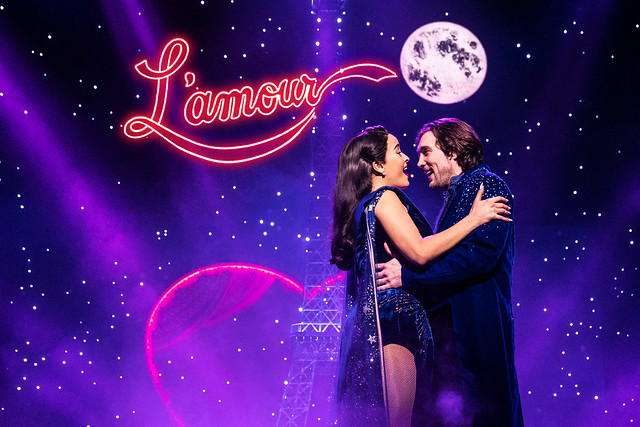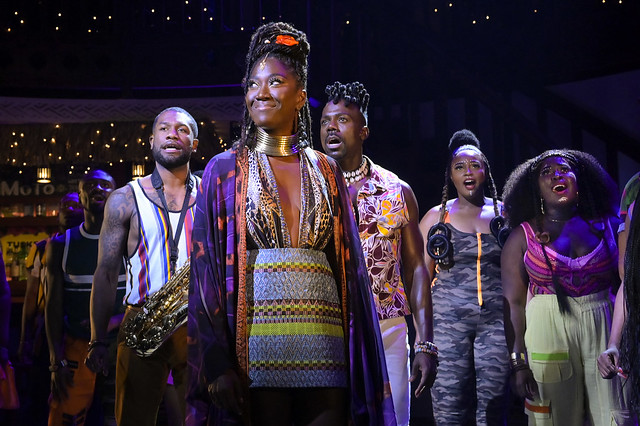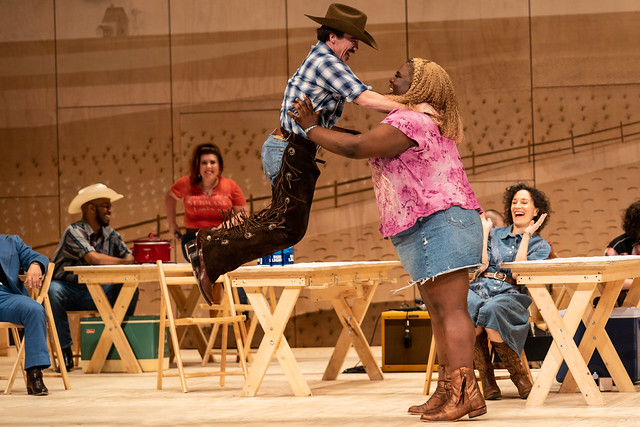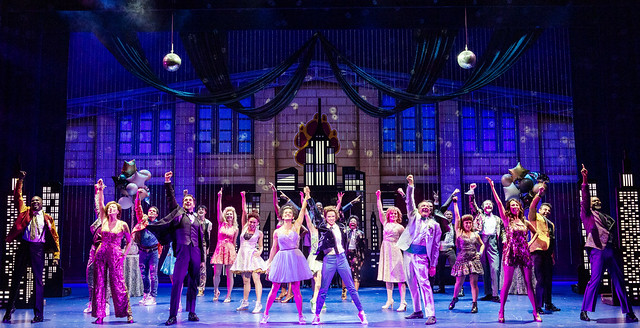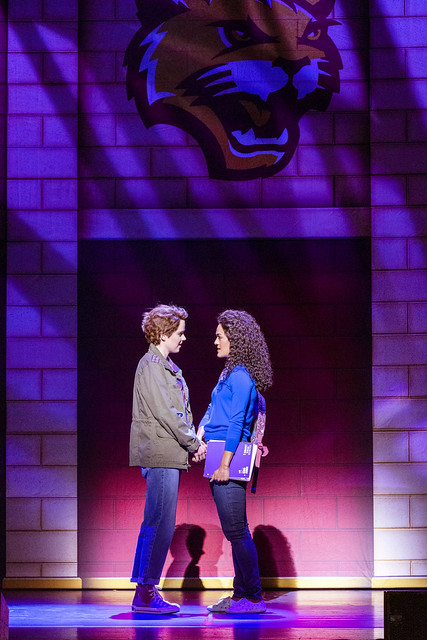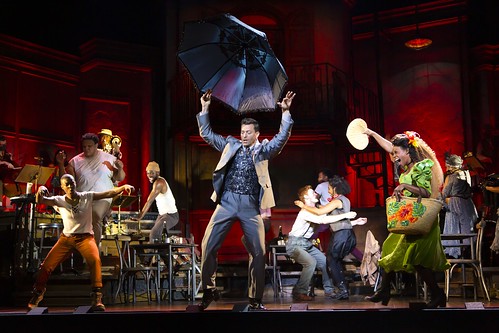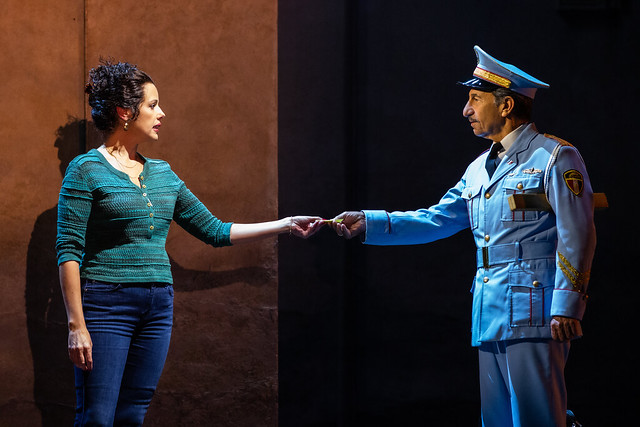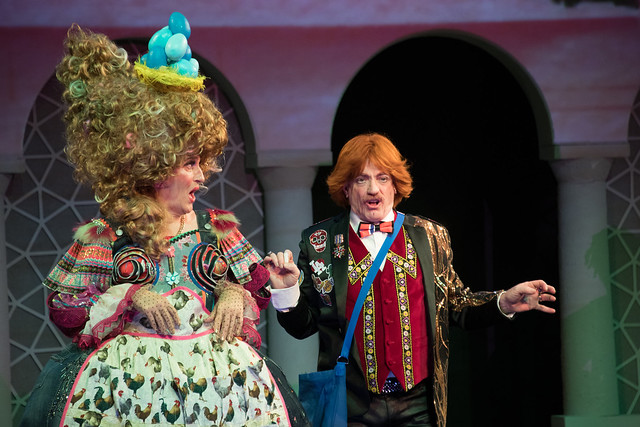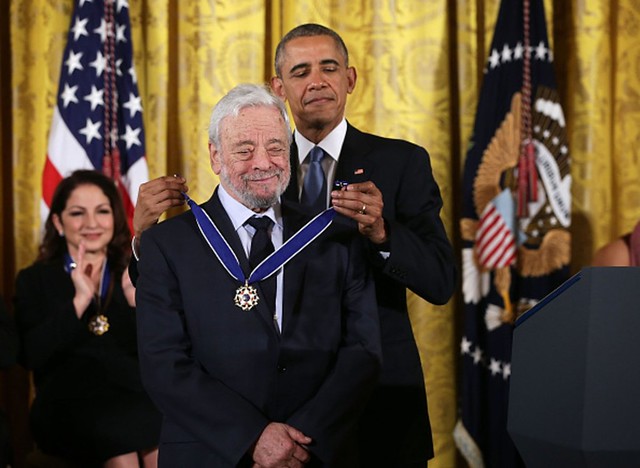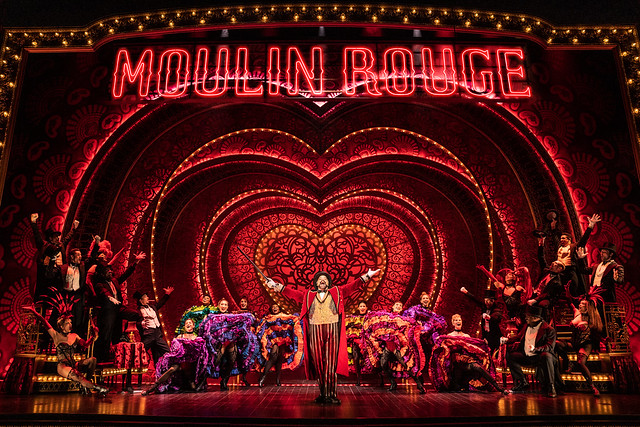
ABOVE: The cast of the North American Tour of Moulin Rouge! The Musical, now at the Orpheum Theatre as part of the BroadwaySF season. BELOW: Courtney Reed as Satine and Conor Ryan as Christian the doomed lovers. Photos by Matthew Murphy for Murphymade
Way back in the early 2000s, I liked the soundtrack of Moulin Rouge much more than I liked Baz Luhrmann’s movie, which left me kind of cold and disappointed that all those mishmashed pop songs I loved on the soundtrack were put to use in a mostly uninteresting La Bohème ripoff movie that primarily coasted on the considerable appeal of Ewan McGregor and Nicole Kidman.
That’s why I was fully prepared not to enjoy the 10-time Tony Award-winning stage adaptation, now known as Moulin Rouge! The Musical. I never saw it on Broadway (where it is still running), but I did catch the tour, which has landed at the Orpheum Theatre for the next two months as part of the BroadwaySF season.
How wrong I was. I loved Moulin Rouge! The Musical, mostly because the music I so revered in the movie has become the heart of the stage show. The idea behind this adaptation, directed by Alex Timbers, written by John Logan and (this is so important) musically supervised by Justin Levine is simple: more, more more. One stage picture is more lavish the next; there’s more melodrama and fire in the performances from the leads to the ensemble; and there are many, many more songs – 75 songs to be exact, crammed into this 2 1/2-hour show, mostly in medley form. And they run the gamut from The Rolling Stones to Dolly Parton and Edith Piaf to David Bowie.
This show revels in the joy, the corniness and the deep attachments that are embedded in pop music. To sit with an audience that audibly reacts to a song’s opening lyrics as if to say, as one, “Oh, I love this song!” Or that murmured chuckle of recognition when an unlikely character starts sliding into a Rhianna song or some newfound friends find themselves Rick-rolled in a charming medley that starts with Rodgers and Hammerstein, morphs briefly into the theme from “Dawson’s Creek” (aka “I Don’t Want to Wait by Paula Cole) and then makes way for The Police.
Moulin Rouge! The Musical loves, reveres and occasionally derides pop music. The melodrama of the plot (still a consumptive slice of La Bohème) is merely a canvas on which to create a sound collage that exalts, among many others, Adele, Lady Gaga, Labelle and, most reverently, Elton John.
As Noël Coward put it in Private Lives, “Extraordinary how potent cheap music is,” and here’s a whole, splashy, gaudy, gorgeous show to prove him right.
Director Timbers, with repeated jolts of energy from choreographer Sonya Tayeh and her dancers, is like his onstage bohemians. He revels in the pure poppy pleasures of music, which makes this feel less like a traditional musical and more like a party where you’re trying to piece together a story with songs you love and loathe (and songs you love to loathe, a fascinating and abundant category). The ultimate aim is to have fun and get carried away – willingly manipulated, some might say – by the nostalgic associations that carbonate so much of the music in our lives.
This is all accomplished by a marvelous cast headed by Austin Durant as Harold Zidler, the owner of and onstage host at the infamous Moulin Rouge awash in the red lights of Paris’ Montmartre district. His star, or as he keeps putting it, his sparkling diamond, is Satine, played by Courtney Reed, whose singing is superior to her acting (the preferred order of things here), and his goal is to keep his struggling club afloat. To do that, he needs Satine to charm Duke Money Bags (actually the Duke of Monroth, played by the delectably sharp David Harris). But wouldn’t you know that poor old Satine, just about to succumb to consumption (even though she can still hit those amazing power notes in her songs), falls in love. The unlikely object of her affection is the penniless American composer Christian, just arrived in Paris, who immediately falls under the spell of newfound friends Toulouse-Lautrec (André Ward) and the robust Argentine Santiago (Gabe Martìnez.
This is really Christian’s story, and Conor Ryan’s performance makes for a dazzling centerpiece. His voice makes you understand why the worldly Satine would fall for such a naïf, and his hair flips make you see how she might go weak in the knees for someone who can’t help her financially. Sinewy and sexy, this Christian has so much charm you actually feel for him when he gets his heart broken and goes on a green-hued absinthe bender.
This frenzied show doesn’t have the cheap, scaled-down feel of many touring productions. Rather, the dazzling atomic-powered Valentine sets by Derek McLane and giddy costumes by Catherine Zuber feel like rich and lush elements in a fantasy world where people express themselves almost exclusively in pop songs and athletic dance.
When all the elements come together, as in the deliriously dreamy close of Act 1 with an elephant-sized love song medley, the result is pure musical theater heaven. Or when, after the inevitably sad ending, the cast heads into a mega-mix curtain call that involves audience sing-along, confetti and even a little Offenbach.
The key to a jukebox musical’s success is tapping into what people love about the chosen music in the first place and giving it a new spin. With its fun-loving attitude, party vibe and all-around gorgeousness, Moulin Rouge! The Musical is the most sumptuous Broadway jukebox yet.
FOR MORE INFORMATION
Moulin Rouge! The Musical continues through Nov. 6 at the Orpheum Theatre, 1192 Market St., San Francisco. Tickets are $61-$256. Call 888-746-1799 or visit www.broadwaysf.com.

